| |
|
The territory of Manciano is samong the most attractive and evocative in Maremma: with the view spanning from Amiata to the valleys of Fiora and Albegna, from Talamone to the beaches of Montalto di Castro, from Argentario to the islands of Giglio, Montecristo and Corsica.
Manciano is a town of medieval aspect which unfortunately has been partly disfigured by large modern apartment blocks. Manciano is the largest comune of the whole province of Grosseto. In the highest part of the dwelling area there opens the picturesque Piazza Garibaldi were you can admire the monumental fountain of Rosignoli built in 1913 by the occasion of an inauguration of the aqueduct, and the monument of Pietro Aldi, a painter of Manciano. Behind the piazza stands out the majestic Fortress, from which one can enjoy a suggestive panorama from Mount Amiata to the Tyrrhenian Sea.
The fortress, perhaps medieval in origin, was rebuilt at the beginning of the 1400s after the town was conquered by Siena. The building, located in the upper part of the town, has a rectangular layout and a scarp base. The building, currently the City Hall, houses works of art by two important Manciano painters. Located in the main offices are La baldoria carnevalesca, an unfinished painting by Paride Pascucci dated 1940, and Il giuramento di Ghino di Tacco by Pietro Aldi, dated 1872.
The Church of S. Leonardo preserves a painting of a Mancianese artist Paride Pascucci, representing San Leonardo che adora la Sacra Famiglia, a baptismal font (XIV sec.), a holy water fond (XVI sec.), a processional cross (second half of the '700).
The Church of the Santissima Annuziata, built outside the impressive city walls during the Middle Ages, is a very simple building but is home to some beautiful frescoes.
The torre dell'orologio (watch tower) was a part of the most ancient town palace of Manciano, built in the XV century. In the street Via Roma, ancient portals (one dated 1472) and renaissance windows prove its importance. A round tower next to the Porta Fiorella and a small tower in Via Trento, is all that has remained from the wall made out of six towers, five of which had shields and two doors of access. The Church of SS. Annunziata, propably of XV century, preserves in its interior a painting of Annunciazione (Annunciation) of Pietro Aldi (1875), and a fresco of Sienese school of the XVIII sec. representing the Annunciation, as well.
Inhabited since prehistory, there are several archaeological evidences such as: the prehistoric village of Scarceta, the necropolis of Pian di Palma and of Puntone (Saturnia), the necropolis of Le Calle (Manciano), the cylinder tower and the castellum aquarum (a giant cistern of Roman Age, close to Poggio Murella). In Manciano, the Museum of Prehistory and Protohistory are worth visiting. This is where the modern exposing conception takes you from the Palaeolithic period to the Final Bronze Age.
|
|
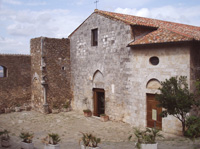
Chiesa di San Giorgio in Montemerano
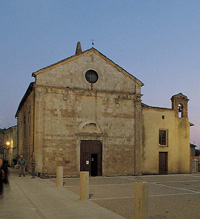 Chiesa Chiesa di San Giovanni Battista Chiesa Chiesa di San Giovanni Battista
in Magliano in Toscana
|
The Poggio Buco Necropolis, of great interest both historical and landscape, lies on a table-land that is attainable covering at first the state road n.74 from Manciano towards Pitigliano. The necropolis was naturally protected by tufaceous cliffs on three sides and the one accessible side was protected by a moat. It has a considerable variety of tombs. The oldest (VII-VI century B.C.) are the fossa type (a rectangular chamber dug into the tufa and covered with slabs). The most recent ones (V-IV century B.C.) are of the chamber type with coffered or pitched ceilings with simulated beams.
[read more]
|
|
|
North of Manciano is Montemerano. The densely built town centre of the frazione Montemerano, crowned by its leaning Torre di San Lorenzo, is contained within its ancient walls. Montemerano is an ancient agricultural farm center risen on the top of a hill, whose slopes are covered with olive trees, it maintains, within its walls, an ancient medieval castle.
Montemerano became a power center of the signori dei Baschi, who dominated the comune. The thirteenth-century church is dedicated to San Lorenzo. Frescoes remain on its walls, and a polyptych by the Sienese painter Sano di Pietro. At a short distance, in open countryside, is the church of the Madonna del Castuzzo.
Its Parish church is rich in works of the year 1400, among them the characteristic Virgin della Gattaiola actually placed in the chorus. In the past the painting was employed as a barn door and therefore an opening was made on it to let the cat pass (the Italian gatto) from which came the name della gattaiola.
The little village of Marsiliana is completely surrounded by 2800 hectars of woodland and Mediterranean bush.
At Marsiliana has been located the city of Caletra, one of the most conspicuous centre of the Vulci area, destroyed in the VII cent. BC.
In the surroundings there are many important necropolises characterised by circular pit tombs. From the Ivory Circle come the pyx, the comb and the ivory writing tablet.
The Marsiliana Nature Reserve covers an area of about 450 hectares, almost all of which is contained in the Interprovincial Park of Montioni. The Reserve is open to visits only after booking. For information contact the Administration Office of the Forest Rangers (tel: 0566/40019).
Eastwards from Marsiliana, on a hill above the torrent Elsa, you can find the ruins of the castle of Stachilagi, which was destroyed by Sienese in 1409.
|
|
|
Poggio Murella is a small village made up by a nucleus of houses. The Church of St. Giuseppe is found in the centre. At the back of the modern construction there is a singular monument of Roman age: cylindrical tower in opus reticulatum. The castellum aquarum, situated in the locality Le Murella, is archaeologically very important. It is a giant cistern of a rectangular shape.
|
|
|
Monastery of San Benedetto alla Selva
The ruins of the ancient Benedictine monastery of San Benedetto alla Selva can be seen in the territory of Manciano, not far from the Stachilagi Castle. The complex is surrounded by flourishing vegetation and includes a church, the refectory and a cloister, onto which the monks’ cells face.
It is interesting to note how the building has a layout quite similar to that of the Monastero di Sant’Angelo Rovinato in Orbetello, which also includes a church set against a cloister with an adjacent refectory, monk’s cells and a capitular hall.
Magliano in Toscana is located about 25 km southeast of Grosseto. Throughout the territory of Magliano numerous necropolises are scattered, with hypogeum camera tombs - evidence of Etruscan occupation of this area.
The Magliano Centre of Archeological Documentation is located in the centre of the town.
The municipality of Magliano in Toscana contains the frazioni Montiano and Pereta.
Comune
The Necropolis of Santa Maria in Borraccia
Address:
Santa Maria in Borraccia, Strada consorziale Colle Lupo - Magliano in Toscana (GR)
Comune Manciano
www.infoturismo.comune.manciano.gr.it | Infoturismo is the new online tourist information service offered by the Municipality of Manciano. The website, recently setup by the local authority, is totally dedicated to tourists.
|
|
|
| Frazioni Montemerano, Saturnia, Poggio Murella, Poggio Capanne, S. Martino sul Fiora, Marsiliana |
|
|
|
|
|
|
| |
|
Saturnia has many monumental buildings and statues that stand as a testament to its ancient past and culture. These include the Church of Santa Maria Maddalena; the main square with its Roman columns; the ancient city walls, erected under the dominion of the Roman Empire and later restored by Siena; and finally the Porta Romana door, once the only access point into the fortified city.
Saturnia is well known for its thermal waters of sulfureous nature, springing in a valley at about 5 kilometers from the village of Saturnia. The fame of Saturnia is closely linked to these thermal springs, the Terme di Saturnia, known since Roman times. Southern Tuscany, in the area around Monte Amiata, has many natural hot springs.
According to a legend, Terme di Saturnia, also known to the Etruscans and Romans, were formed at the point where he fell to Earth lightning that Jupiter scagliò against Saturn, mancandolo, following a violent dispute broke out between the two mythological deity.
An alternative to the thermal center is the Mulino water falls (known as Cascate del Gorello), free access, placed to 2 km from the village of Saturnia.
The source of the Saturnia thermal waters spring from a volcanic crater (where is the Resort’s main pool) the waters slides subsequently along a natural stream for about 500 meters, and forms, near an ancient watermill, a waterfall and many little natural pools dug in the cliff. The waterfalls are called Waterfalls of Mulino, because the water flows near an old ruined mill.
[read more]
The territory’s origins date back to before the Romans and Saturnia is close to one of the most important Etruscan necropolis in central Italy, Puntone, not to mention just minutes from a pre-Etruscan place of worship known as the Holy Bath.
Saturnia has many monumental buildings and statues that stand as a testament to its ancient past and culture. These include the Church of Santa Maria Maddalena; the main square with its Roman columns; the ancient city walls, erected under the dominion of the Roman Empire and later restored by Siena; and finally the Porta Romana door, once the only access point into the fortified city.
|
|
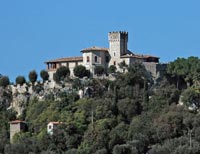
Saturnia
|
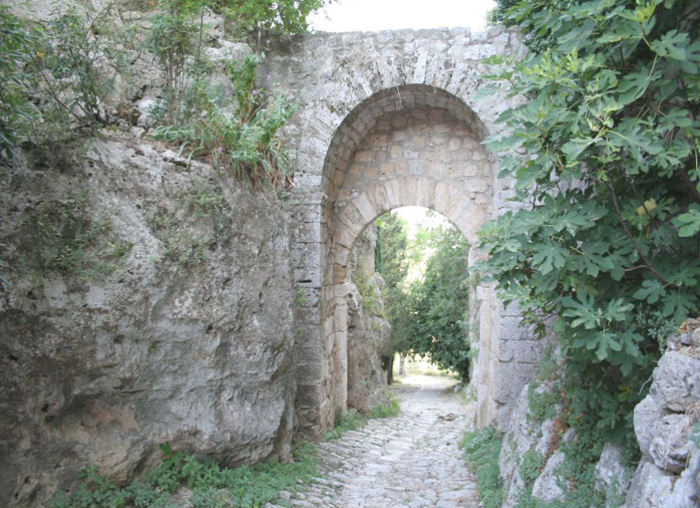
|
Saturnia, Porta Romana
|
Manciano borders Canino, Capalbio, Ischia di Castro, Magliano in Toscana, Montalto di Castro, Orbetello, Pitigliano, Roccalbegna, Scansano, Semproniano and Sorano.
Montemerano, Saturnia, Poggio Murella, Poggio Capanne, S. Martino sul Fiora, Marsiliana are frazioni of Manciano.
Among the numerous celebrations taking place in Manciano we point out the traditional Strawberries Festival held yearly on May.
|
|
| |
 |
Reemerging from oblivion are the vie dell'acqua, a network of paths, cattle routes and rural walkways that cross through the Maremma area. This web of paths existed as early as the 1200s and was even used up to the immediate postwar era, when transportation technologies were revolutionized. Now, after a century of disuse, during which the vegetation swallowed up the faint traces of human activity, it is a time of rediscovery, with eight identified paths.
Three of them have been opened up to tourists who wish to delve into Maremma at a leisurely pace on foot, on horseback or by mountain bike. These are the via del castelli, which leads to the ruins of the Stachilagi castle and the Marsiliana fortress, the path that leads to Monte Sugherello, and the ancient via del sale, which goes all the way to Argentario. All three take visitors through a realm of history and local legend. The hub of this age-old system of roads is Saturnia.
Touristic-cultural Itineraries of the City Manciano
|

Photo Gallery Manciano and Saturnia
|
|
|
 |
|
 |
|
 |
| Manciano, Saturnia album |
|
Monumento a Pietro Aldi in piazza Garibaldi a Manciano, è stato realizzato dallo scultore Vincenzo Rosignoli ed inaugurato nel 1911
|
|
La casa natale di Pietro Aldi a Manciano
|
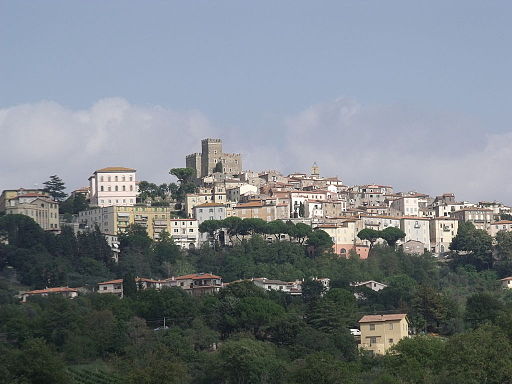 |
|
 |
|
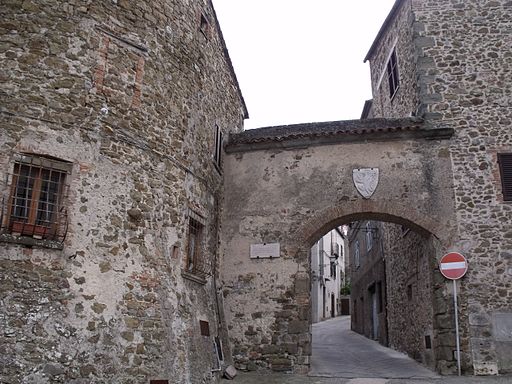 |
Manciano
|
|
Manciano, Rocca
|
|
Porta Fiorella
|
Photo Gallery Saturnia
|
|
|
 |
|
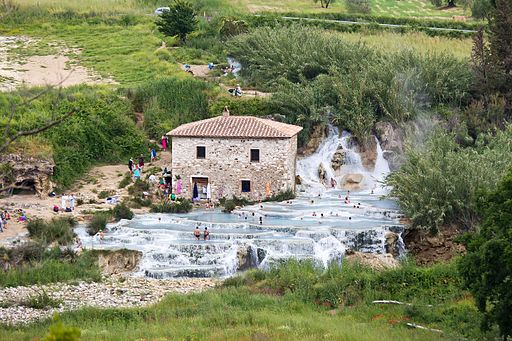 |
|
 |
| Manciano, Saturnia album |
|
Saturnia, Cascate del Gorello, Molino |
|
Saturnia, Cascate del Gorello (detail) |
 |
|
 |
|
 |
| Via Clodia & Porta Romana |
|
Saturnia, Cascate del Gorello
|
|
Saturnia, Cascate del Gorello
|
 |
|
 |
|
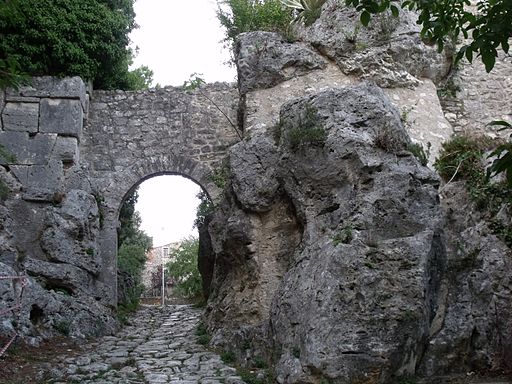 |
Saturnia
|
|
Saturnia, Rocca
|
|
Saturnia, Mura e Porta Romano |

15. La via delle Terme | The Road to the Termal Baths - 37.2 km
Manciano - Montemerano - Terme di Saturnia - Saturnia - Poggio Capanne - Poggio Murella - Manciano
16. Poggio Foco | Poggio Foco - 29 km
Manciano - Lago Scuro - Capriola - Bivio Capalbio - S.P. 67 - La Campigliola - Attraversamento S.P. 32 - S.R. 74 - Manciano
|

La Maliosa | Organic Farming in Tuscany
La Maliosa is a small farm near Saturnia, is strictly organic and completely wedded to environmental biodiversity. The choice of Biodynamic Agriculture was immediate and fundamental to increase biodiversity and the soil’s fertility.
The red and white wines are made entirely by hand, partially from wild vines, without sulfur and are not filtered, and fermented in their own yeasts in reconditioned wooden oak tonneaux and barriques.
Fattoria La Maliosa Loc. Podere Monte Cavallo
58014 MANCIANO (GR) Italia
www.fattorialamaliosa.it
Fattoria La La Maliosa is certified organic (CCPB Bologna) and biodynamic (Demeter).
The farm shop on Via del Ponticino in Manciano |www.fattorialamaliosa.it/en/prodotti/vendita-diretta
e-mail: info@fattorialamaliosa.it
Wines in Tuscany | Organic winegrowing in southern Tuscany
The Festa delle Cantine
The Festa delle Cantine celebrates the two great loves of every Mancianese: food and wine. For locals it’s an opportunity to enjoy the incredible wines and products they are renowned for not only within the territory, but in all of Italy.
During the festival, held on Friday, Saturday and Sunday in the second week of September, the entire town comes together to enjoy live shows, musical performances, market stalls and various homemade delicacies.
Wine, ciaffagnoni (local doughnuts), fried pizzas, bruschettas and other local dishes are in abundance and everyone is invited to join in roaring choruses of traditional songs.
Ciaffagnoni are local savoury pancakes made with water, eggs, flour and salt. When Caterina de Medici married the Duke of Orleans in 1533, second son of the king of France, she took cooks and pastry chefs with her and packed her suitcases with extra-virgin olive oil and pecorino cheese. She took to France the smells and aromas of Tuscan cuisine and her recipes were enjoyed to the point that they became actual French specialties. Local people said that one of Caterina’s cooks were from Manciano, so ciaffagnoni could be the ancestors of the famous French crepes.
Restaurants in Manciano
Trattoria Da Paolino
Via Marsala, 41, 58014 Manciano, Italia
La Filanda a Manciano
Via Marsala, 8, 58014 Manciano GR, Italië
+39 0564 625156
www.lafilanda.biz
Caino
via della Chiesa 4 58050 Montemerano
www.dacaino.it/
Trattoria Verdiana
località Ponticello di Montemerano 58014
La Limonaia
località Acquaviva 10 58050 Montemerano
|

Podere Santa Pia, is located on the slopes of Monte Labbro, and overlooks the Maremma plain, approximately forty kilometres from the Tyrrhenian Sea. Podere Santa Pia is an authentic holiday home in Castiglioncello Bandini, a small village in the Maremma, in the south of Tuscany, situated half way between Florence and Rome and close to Montalcino, Arcidosso and Monte Amiata.
Here you find the perfect vacation rental for your needs and desires.
Enjoy fine wine, cheeses and explore medieval Montalcino and Pienza. Explore the medieval hillside villages of Montepulciano, Montefollonico and Montichiello. Marvel at settlements that date back to Etruscan times, and try some Pecorino cheese in Pienza, and some Vino Nobile in the stately Renaissance village of Montepulciano, where the refined beauty of the churches blends perfectly with the ancient traditions of its wines.
The house offers four large bedrooms on the first floor with a total of eleven accommodations. The property is ideal for a families or larger groups of guests.
Case vacanza in Toscana | Podere Santa Pia
|
 |
Podere Santa Pia, offering views on the Maremma hills, up to the Tyrrhenian coast, the island Montecristo and on clear evenings even Corsica.
|

[1] Ciaffagnoni is a family recipe. Generally, you can only find them during Festa delle Cantine, every year in September (when the best ciaffagnoni are made). Nevertheless, some local restaurants as La Filanda offer this specialty all year round.
Ciaffagnoni recipe
Serves: 4
Ingredients
- 4 eggs
- 350 ml of water
- 100 g of white flour
- 1 pinch of salt
- Lard (cold cut)
Method
- Mix all the ingredients together and let the mixture stand overnight. The dough will be ready when there’s no foam on the surface.
- Take an iron pan, grease it with a piece of lard, take the mixture with a spoon and pour it in the middle of the pan and proceed as for the preparation of crêpes. They must be so thin (almost transparent) so that they’re see-through.
- When they are ready, very hot, sprinkle with grated pecorino cheese and enjoy!
Source and recipe: www.turismo.intoscana.it
|
|
|
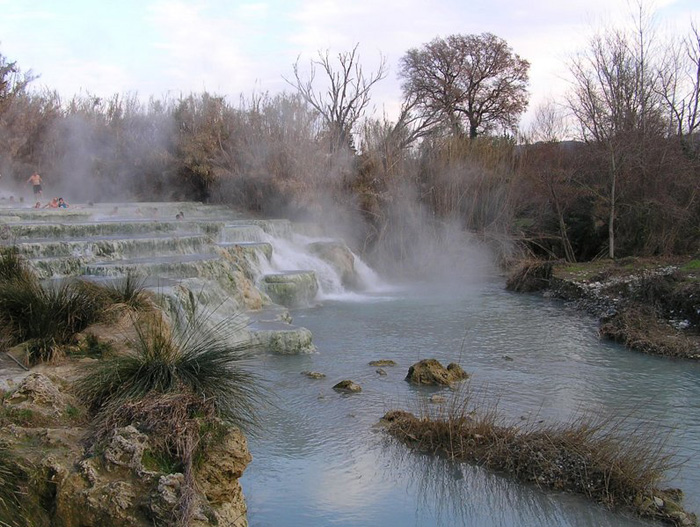

















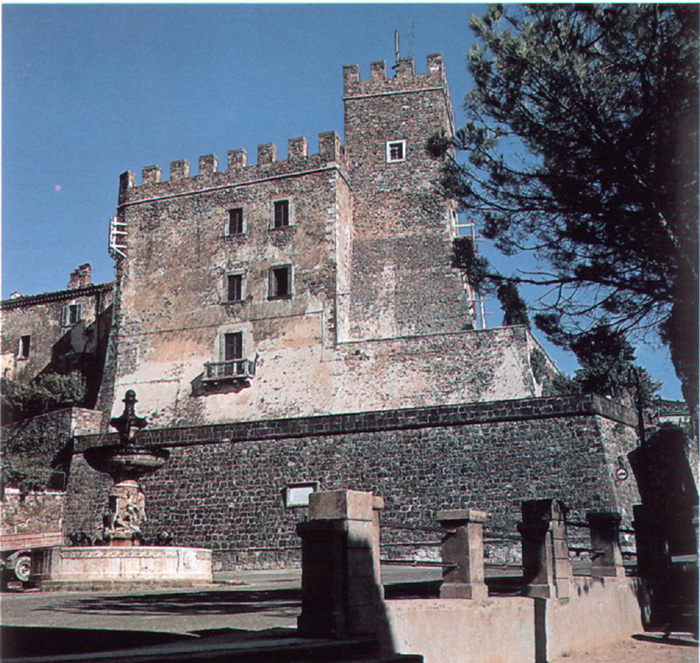

 Chiesa Chiesa di San Giovanni Battista
Chiesa Chiesa di San Giovanni Battista
